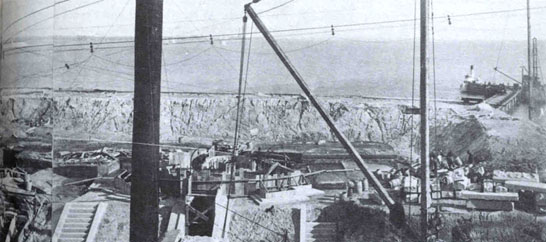Under the Threat of War, the Baltimore District Mobilized its Civil Works Organization to Defend the Homeland
From the Civil War to the end of the nineteenth century, the Corps of Engineers concentrated on river and harbor projects. Congress kept appropriations for seacoast fortifications small. But in 1898, on the eve of war with Spain, the Corps of Engineers skillfully mobilized its civil works organization for defense. In Baltimore, Maryland, one of the nation’s major commercial centers at the time, the Corps hurriedly built gun emplacements for partially constructed batteries from the mouth of the Patapsco River to the Inner Harbor. Chief of Engineers Brig. Gen. John M. Wilson realized that in such a crisis the reputation of the Corps of Engineers was at stake. He urged Baltimore District Engineer Col. Peter C. Hains to “show what the Corps of Engineers can do when an emergency arises for which the country is unprepared.”
During the spring of 1898, crews worked double shifts using every available daylight hour pouring concrete and mounting guns to protect Baltimore’s harbor. By June, the battery at North Point at the confluence of the Patapsco and Chesapeake Bay had eight platforms ready for 12-inch mortars. Close to the Inner Harbor, the Corps mounted 8- and 12-inch guns at Hawkins Point and old Fort Carroll.
At the same time, Colonel Hains supervised the planting of mines in the harbor itself. The entire operation was shrouded with the utmost secrecy. Between 23 April and 12 May, workers placed explosives in the water. Hains had them arranged 400 feet apart in two lines on each side of the channel. Engineers kept the mines for blocking the middle of the channel ready on shore “to be promptly laid,” Hains wrote Chief Wilson, “when danger is imminent—say after an enemy’s fleet has arrived in the Chesapeake Bay.”
Fortunately, the Spanish fleet never got that close. By July, the Spanish military had been crushed. But in the emergency, the Corps of Engineers’ Baltimore District had effectively transformed its civil works structure to protect the populace. In August, Hains exploded the mines in the harbor in a dramatic fireworks display.
 |
|
 |
| Hawkins Point during construction of gun emplacements in the spring of 1898, harbor in the background (National Archives) |
|
Colonel Hains ordered unused mines to be detonated in Baltimore's harbor (National Archives) |
* * *
May 2003